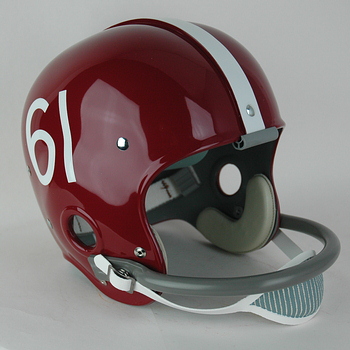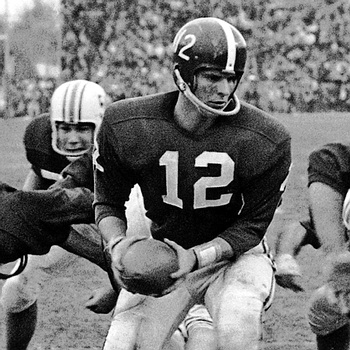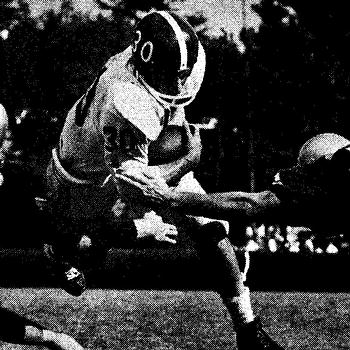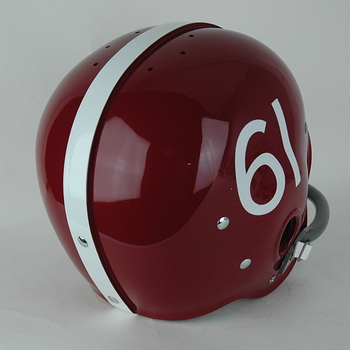

Alabama
1961 Crimson Tide
(Authentic Reproduction)
 |
 |
 |
 |
 |
THE NATIONAL CHAMPIONSHIP SEASON OF 1961:
Tide fans were treated to great football in 1961 and an "alternating uniform look". Fan response to the cardinal helmet that was introduced for the 1960 Bluebonnet Bowl was so positive that it was utilized as the primary helmet color for 1961, and thereafter during the Coach Bryant era. The ’61 helmet was augmented with a one-inch white center stripe and white three-inch rounded Charger style numerals on each side, replacing the block style numbers previously used. Especially in the early Sixties, Bryant would use an “alternate” white shell with one-inch cardinal center stripe and cardinal numerals on each side to better differentiate his players from those opponents wearing similarly colored helmets. In 1961, the white shell numerals matched the rounded style applied to the cardinal shells.
Alabama football had truly arrived and the defense became a nationally recognized quality. The squad's 11-0 finish was dangerous enough but this 1961 National Championship team was forged behind six shutouts, two three- point games, and a total of twenty-five points yielded the entire year! Center/linebacker Lee Roy Jordan and 6’, 250 pound tackle Billy Neighbors who later had a respectable eight-year career in the AFL and is a member of the Patriots All Decade Team of The Sixties, were both All Americans, the Tide’s first since 1950. Neighbors was inducted to the College Football Hall Of Fame and his son Wes followed in his father’s footsteps as a Bama All SEC center in the mid-1980s. Standouts included All SEC back Mike Fracchia, All SEC end George “Butch” Wilson, Tommy Brooker the future end and kicker for the AFL Texans, tackle Steve Wright, end Bill Battle, and halfback Ray Abruzzese, who became better known as Joe Namath's Jets roommate and companion-about-town although he was a very good defensive back for the Jets and Bills. “Brother” Bill Oliver who won notice as the defensive coordinator at Auburn and Alabama, Charley Pell, Richard Williamson, and Paul “Jack” Rutledge were among those that later made a lasting name for themselves in the coaching ranks.
It was Trammell however, a three year starter and long-noted as Bryant's favorite quarterback who later became a physician, who was the engine that drove the Tide to its dizzying heights. He insured that the team played to its ability. Bryant had said, "I think early in the season that they were the nicest, even the sissiest bunch I'd ever had. I think they read it because later on they got unfriendly" and again it was Trammell who “didn’t do anything exceptionally well except win” that led the transformation. Trammell tragically died at the age of twenty-eight but he began the Bryant legacy of excellence at Alabama. The Tide had worn their white helmets on November 11 for their 66-0 stampede over Richmond and this great year of Alabama football ended with a 10-3 victory over Arkansas in the Sugar Bowl where the Tide finished the season in their white helmets. The white shell would be "semi-retired" after this successful outing, worn only for "special occasions" when Coach Bryant felt a slight motivational push was necessary. Into the mid-sixties, Bama would also use the white helmets on eligible receivers in those games played at night, or when the opponent's helmet matched or resembled the Tide's cardinal shells. No matter what color the headgear was however, the 1961 squad that finished the season ranked number two in rushing defense and national leaders against scoring and total defense solidified the Bryant/Alabama tradition of swarming, gang-tackling defensive football.
SPOTLIGHT ON PAT TRAMMELL:
In describing Pat Trammell, it has been said that he “was special, distinctive, and an exception not just to the norm, but even to the greatness that surrounded him on the Alabama football team from 1958-61.” He was held in such high regard by Coach Bryant that he was perhaps the only player of his era that could argue with his coach, refuse to call the plays sent in from the sidelines, and discuss serious team concerns with the staff. Known as Paul Bryant’s “favorite player” there are many that add “he was Bryant’s favorite person.” It was also often said that Trammell did not run or pass well but he “won better than anyone else. All he could do was beat you.” As impressive as leading the ’61 team to the National Championship and 11-0 record was, his 26-2-4 mark as a starter places him among Bama’s all-time quarterback leaders. Described by teammates as “very smart, mentally and physically tough, and a great competitor,” he was Bryant’s perfect team leader. Although his physical abilities were always mentioned behind his outstanding competitiveness and intelligence, Trammell was athletic enough at Scottsboro (Alabama) High School to earn All State, All Southern, and All American status as a quarterback and was the State MVP in basketball. His great grandfather and father were physicians and as a summa cum laude graduate in physical chemistry, his goal was to become a physician also. He completed his senior season as an All American, the Most Valuable Player in the Southeastern Conference, Academic All American, and First Team All SEC among numerous other awards. He finished fifth in the Heisman Trophy balloting and was voted as the 1961 Collegiate Player Of The Year. Although Vince Lombardi personally told him and Coach Bryant that Trammell was in fact a viable professional prospect, Bryant pushed him to medical school and he became a dermatology specialist. He and Bryant remained close, becoming closer when tragically, Trammell contracted metastatic testicular cancer in 1968. He passed away on December 10, 1968 and his former head coach stated that the day Pat died “was the saddest day of my life.” Trammell’s children were the first recipients of scholarships to Alabama from the Alabama A-Club Educational and Charitable Foundation that was established in response to Trammell’s passing. A new stadium built in Scottsboro was named for Trammell, the great quarterback was posthumously inducted into the Alabama Sports Hall Of Fame, and a Sports Medicine Fellowship and Chair in his recognition was endowed at the Alabama School of Medicine.
If interested in any of these Alabama helmets please click on the photos below.